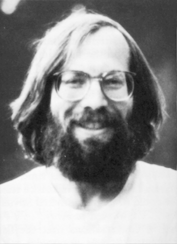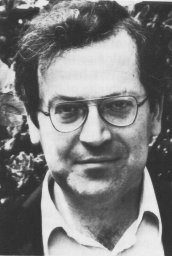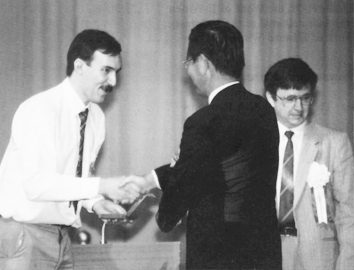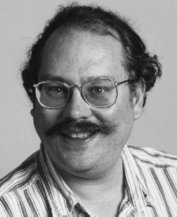| 1982 |
|
| |
|
 |
Robert
TARJAN
received the first Nevanlinna Prize for outstanding contributions
to mathematical aspects of information science. "Pure mathematics
enjoys the luxury of studying its constructions, whether finite
or infinite, in complete independence of all questions of efficiency."
explained Jacob Schwartz, who spoke on Tarjan's work. "By contrast,
theoretical computer science must ultimately concern itself with
computing engines which operate with limited speed and data storage,
and therefore must take efficiency as one of its central concerns.
|
|
Two closely related activities, algorithm design and algorithm
analysis, grow out of this inevitable concern."
The awards were announced in 1982 even though the Warsaw Congress
was not held until 1983.
|
| |
|
| 1986 |
|
| |
|
 |
Leslie
VALIANT
``Valiant has contributed in a decisive way to the growth of
almost every branch of the fast growing young tree of theoretical
computer science, his theory of counting problems being
perhaps his most important and mature work''
Volker Strassen
|
| |
|
| 1990 |
|
| |
|
 |
| |
|
A.A.
Razborov (left), the Rolf Nevanlinna Prize winner, Hori
and Lovász
Photo by A. Mizutani
|
| |
|
| 1994 |
|
| |
|
|
- Avi
Wigderson
of the Hebrew University in Jerusalem.
The members of the Fields Medal Committee were: Luis Caffarelli,
Masaki Kashiwara, Barry Mazur, David Mumford (chair), Alexander
Schrijver, Dennis Sullivan, Jacques Tits, and S. R. S. Varadhan.
The members of the Nevanlinna Prize Committee were: Hendrik Lenstra,
Jacques-Louis Lions (chair), Yuri Matiyasevich, Robert Tarjan, and
K. Yamaguti.
During the afternoon following the Opening Ceremonies, lectures
about the contributions of the awardees were presented: Luis Caffarelli
of the Institute for Advanced Study spoke on the work of Bourgain;
S. R. S. Varadhan of the Courant Institute of Mathematical Sciences
at New York University spoke on the work of Lions; Adrien Douady
of Université de Paris-Sud (Orsay) spoke on the work of
Yoccoz; Walter Feit of Yale University spoke on the work of Zelmanov;
and Yuri Matiyasevich of the Steklov Institute of Mathematics
in St. Petersburg spoke on the work of Wigderson.
|
| |
|
| 1998 |
|
| |
|
 |
Peter Shor
(born 14 August 1959)
He is mathematician at the AT&T Labs in Florham Park, New Jersey
(USA). His research interests include quantum computing, algorithmic
geometry, and combinatorial analysis. After studying at California
Institute of Technology (Caltech) he gained a doctorate at Massachusetts
Institute of Technology (MIT). Before going to AT&T in 1986, he
was postdoc for a year at the Mathematical Research Center in
Berkeley, California (USA).
|
| |
|
| Peter
Shor has carried out pioneering work in combination analysis
and the theory of quantum computing. He received worldwide recognition
in 1994 when he presented a computational method for "factorising
large numbers" which, theoretically, could be used to break many
of the coding systems currently employed. The drawback is that Shor's
algorithm works on so-called quantum computers, of which only prototypes
currently exist. Quantum computers do not operate like conventional
ones, but make use of the quantum states of atoms, which offers
a computing capacity far in excess of current parallel supercomputers.
Shor's result unleashed a boom in research amongst physicists and
computer scientists. Experts predict that quantum computers could
already become a reality within the next decade, but this rapid
development is also a cause of concern for some observers. Shor
has been able to prove mathematically that the new computers would
mean that current standard encrypting methods such as "RSA", which
are used for electronic cash and on-line signatures would no longer
be secure. "RSA" was developed in 1977 by the mathematicians Ronald
Rivest, Adi Shamir and Leonard Adelmann (hence the acronym). It
makes use of the fact that factorising a number is a so-called one-way
function. This means that while it is very easy to make a large
number from smaller ones, it is takes much longer to find all the
factors of a large number. This time factor is the basis for the
security offered by many encryption methods. Using Shor's algorithms,
factorising large numbers on a quantum computer would be just as
fast as multiplication. "RSA" and other procedures would no longer
be safe. Experts have been making reassuring noises, since a lot
of work remains to be done before such computers can even be constructed,
but cryptographers are already working on the next generation of
encryption techniques. |
| |
|
|
|
This document has been reproduced from
The Website of International Congress of
Mathematicians, Berlin 1998.
Albers, Donald J.; Alexanderson, G. L.;
Reid, Constance:
International mathematical congresses. An illustrated history
1893 - 1986
Rev. ed. including ICM 1986. Springer-Verlag, New York, 1986
with friendly permission from Springer
Verlag
|
|